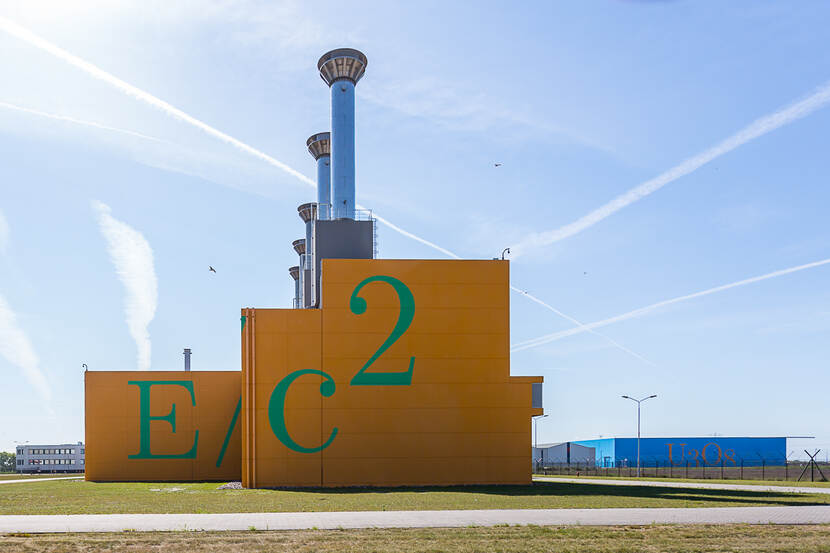 The Netherlands Authority for Nuclear Safety & Radiation Protection (ANVS) has granted the final permit to the Central Organisation for Radioactive Waste (COVRA) for the construction of a multi-functional storage building (MOG) at Borssele, in The Netherlands.
The Netherlands Authority for Nuclear Safety & Radiation Protection (ANVS) has granted the final permit to the Central Organisation for Radioactive Waste (COVRA) for the construction of a multi-functional storage building (MOG) at Borssele, in The Netherlands.
COVRA applied for a permit change under the Nuclear Energy Act in August 2022. The new building will be able to accommodate low- and intermediate-level radioactive waste, stored in stackable containers, making transport and storage more efficient. MOG will also be able to accept other types of waste streams not suitable for the existing buildings on site.
Along with its application, COVRA submitted an environmental impact assessment (EIA) and a supplement to its safety report.
ANVS said its EIA Committee has issued a recommendation on this report and the information on accident scenarios has been supplemented in response to this advice. COVRA has included a mandatory ten-year safety evaluation in the design of the MOG. The Committee also recommended that a more up-to-date nitrogen calculation should be carried out. The ANVS now judges that the information complies with the committee's advice.
ANVS published a draft permit in December for public consultation and received four responses from citizens, an interest group and COVRA itself. "The responses raised questions about the usefulness of the MOG, alternatives and the consequences for nature, among other things," ANVS said. "We have answered these questions and a number of regulations have been amended."
COVRA must now apply for a building permit from the municipality of Borssele. Once the necessary permits have been obtained, the contract for construction of MOG can be put out to tender. Completion of the new building is expected in 2025. COVRA announced plans for the MOG facility in March 2021. It says the new storage building is mainly intended for the storage of historical radioactive waste that is currently stored on the site of medical isotope producer NRG in Petten. Future decommissioning waste from nuclear installations in the Netherlands will also be placed in MOG.
The new 2400m2 building will provide sufficient storage capacity until 2050, and has a design life of at least 100 years. It will be able to accommodate 4000m3 of radioactive waste and its storage capacity can easily be expanded later. The first permit for the current location was granted in 1989. This was replaced in 1998 by an amended permit for the extension of the storage buildings. Since 2002, the Dutch state has owned 100% of COVRA.
COVRA’s 20-hectare grounds contain five storage buildings, a waste-processing building and an office building. The bright orange High Radioactive Waste Treatment & Storage Building (HABOG) was expanded in May 2022. There are two storage buildings for depleted uranium, VOG (Verarmd uranium OpslagGebouw) and VOG-2, LOG (Laag- en middelradioactief afval OpslagGebouw) for the storage of low- and intermediate-level radioactive waste and COG (Container OpslagGebouw) for the storage of containers. HABOG was designed by the artist William Verstraeten. Every 20 years the building will be painted a lighter colour, until in one hundred years it is white. This reflects the fact that heat and radiation produced by the waste stored inside will gradually decrease.
orange High Radioactive Waste Treatment & Storage Building (HABOG) was expanded in May 2022. There are two storage buildings for depleted uranium, VOG (Verarmd uranium OpslagGebouw) and VOG-2, LOG (Laag- en middelradioactief afval OpslagGebouw) for the storage of low- and intermediate-level radioactive waste and COG (Container OpslagGebouw) for the storage of containers. HABOG was designed by the artist William Verstraeten. Every 20 years the building will be painted a lighter colour, until in one hundred years it is white. This reflects the fact that heat and radiation produced by the waste stored inside will gradually decrease.
Image (top): The current buildings on the Covra site and the location of the new MOG building (courtesy of COVRA)
Image (bottom): The existing high-level radioactive waste treatment and storage building (HABOG) at COVRA (courtesy of COVRA)



